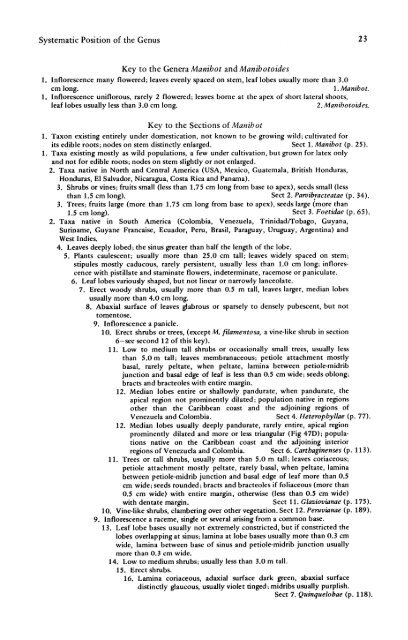Manihot Manihotoides (Euphorbiaceae) - CNCFlora
Manihot Manihotoides (Euphorbiaceae) - CNCFlora
Manihot Manihotoides (Euphorbiaceae) - CNCFlora
Create successful ePaper yourself
Turn your PDF publications into a flip-book with our unique Google optimized e-Paper software.
Systematic Position of the Genus<br />
Key to the Genera <strong>Manihot</strong> and <strong>Manihot</strong>oides<br />
1. Inflorescence many flowered; leaves evenly spaced on stem, leaf lobes usually more than 3.0<br />
cm long.<br />
1. <strong>Manihot</strong>.<br />
1. Inflorescence uniflorous, rarely 2 flowered; leaves borne at the apex of short lateral shoots,<br />
leaf lobes usually less than 3.0 cm long.<br />
2. <strong>Manihot</strong>oides.<br />
Key to the Sections of <strong>Manihot</strong><br />
1. Taxon existing entirely under domestication, not known to be growing wild; cultivated for<br />
its edible roots; nodes on stem distinctly enlarged.<br />
Sect 1. <strong>Manihot</strong> (p. 25).<br />
1. Taxa existing mostly as wild populations, a few under cultivation, but grown for latex only<br />
and not for edible roots; nodes on stem slightly or not enlarged.<br />
2. Taxa native in North and Central America (USA, Mexico, Guatemala, British Honduras,<br />
Honduras, El Salvador, Nicaragua, Costa Rica and Panama).<br />
3. Shrubs or vines; fruits small (less than 1.75 cm long from base to apex), seeds small (less<br />
than 1.5 cm long).<br />
Sect 2. Parvibracteatae (p. 34).<br />
3. Trees; fruits large (more than 1.75 cm long from base to apex), seeds large (more than<br />
1.5 cm long).<br />
Sect 3. Foetidae (p. 65).<br />
2. Taxa native in South America (Colombia, Venezuela, Trinidad/Tobago, Guyana,<br />
Suriname, Guyane Francaise, Ecuador, Peru, Brasil, Paraguay, Uruguay, Argentina) and<br />
West Indies.<br />
4. Leaves deeply lobed; the sinus greater than half the length of the lobe.<br />
5. Plants caulescent; usually more than 25.0 cm tall; leaves widely spaced on stem;<br />
stipules mostly caducous, rarely persistent, usually less than 1.0 cm long; inflores-<br />
cence with pistillate and staminate flowers, indeterminate, racemose or paniculate.<br />
6. Leaf lobes variously shaped, but not linear or narrowly lanceolate.<br />
7. Erect woody shrubs, usually more than 0.5 m tall, leaves larger, median lobes<br />
usually more than 4.0 cm long.<br />
8. Abaxial surface of leaves glabrous or sparsely to densely pubescent, but not<br />
tomentose.<br />
9. Inflorescence a panicle.<br />
10. Erect shrubs or trees, (except M. filamentosa, a vine-like shrub in section<br />
6-see second 12 of this key).<br />
11. Low to medium tall shrubs or occasionally small trees, usually less<br />
than 5.0m tall; leaves membranaceous; petiole attachment mostly<br />
basal, rarely peltate, when peltate, lamina between petiole-midrib<br />
junction and basal edge of leaf is less than 0.5 cm wide; seeds oblong;<br />
bracts and bracteoles with entire margin.<br />
12. Median lobes entire or shallowly pandurate, when pandurate, the<br />
apical region not prominently dilated; population native in regions<br />
other than the Caribbean coast and the adjoining regions of<br />
Venezuela and Colombia. Sect 4. Heterophyllae (p. 77).<br />
12. Median lobes usually deeply pandurate, rarely entire, apical region<br />
prominently dilated and more or less triangular (Fig 47D); populations<br />
native on the Caribbean coast and the adjoining interior<br />
regions of Venezuela and Colombia. Sect 6. Carthaginenses (p. 113).<br />
11. Trees or tall shrubs, usually more than 5.0 m tall; leaves coriaceous;<br />
petiole attachment mostly peltate, rarely basal, when peltate, lamina<br />
between petiole-midrib junction and basal edge of leaf more than 0.5<br />
cm wide; seeds rounded; bracts and bracteoles if foliaceous (more than<br />
0.5 cm wide) with entire margin, otherwise (less than 0.5 cm wide)<br />
with dentate margin.<br />
Sect 11. Glaziovianae (p. 175).<br />
10. Vine-like shrubs, clambering over other vegetation. Sect 12. Peruvianae (p. 189).<br />
9. Inflorescence a raceme, single or several arising from a common base.<br />
13. Leaf lobe bases usually not extremely constricted, but if constricted the<br />
lobes overlapping at sinus; lamina at lobe bases usually more than 0.3 cm<br />
wide, lamina between base of sinus and petiole-midrib junction usually<br />
more than 0.3 cm wide.<br />
14. Low to medium shrubs; usually less than 3.0 m tall.<br />
15. Erect shrubs.<br />
16. Lamina coriaceous, adaxial surface dark green, abaxial surface<br />
distinctly glaucous, usually violet tinged; midribs usually purplish.<br />
Sect 7. Quinquelobae (p. 118).<br />
23

















